Transport Systems: Electric Vehicles, ITS, and Planning Analysis
VerifiedAdded on 2020/10/05
|21
|7709
|497
Report
AI Summary
This report delves into the realm of electric vehicles (EVs) and intelligent transport systems (ITS), exploring their historical development, current applications, and future trends. The report provides a comprehensive overview of EVs, including their advantages (environmental benefits, cost-effectiveness) and disadvantages (limited range, high initial investment), and examines the role of various technologies in generating electricity for EVs, such as solar power and brake charging. The report also explores ITS, detailing its evolution, the technologies employed (wireless communication, computational techniques), and its impact on traffic management and traveler information. Furthermore, the report briefly touches on transportation planning and utility cycling, offering a holistic view of sustainable urban mobility. The content is contributed by a student and available on Desklib, a platform offering AI-based study tools for students.
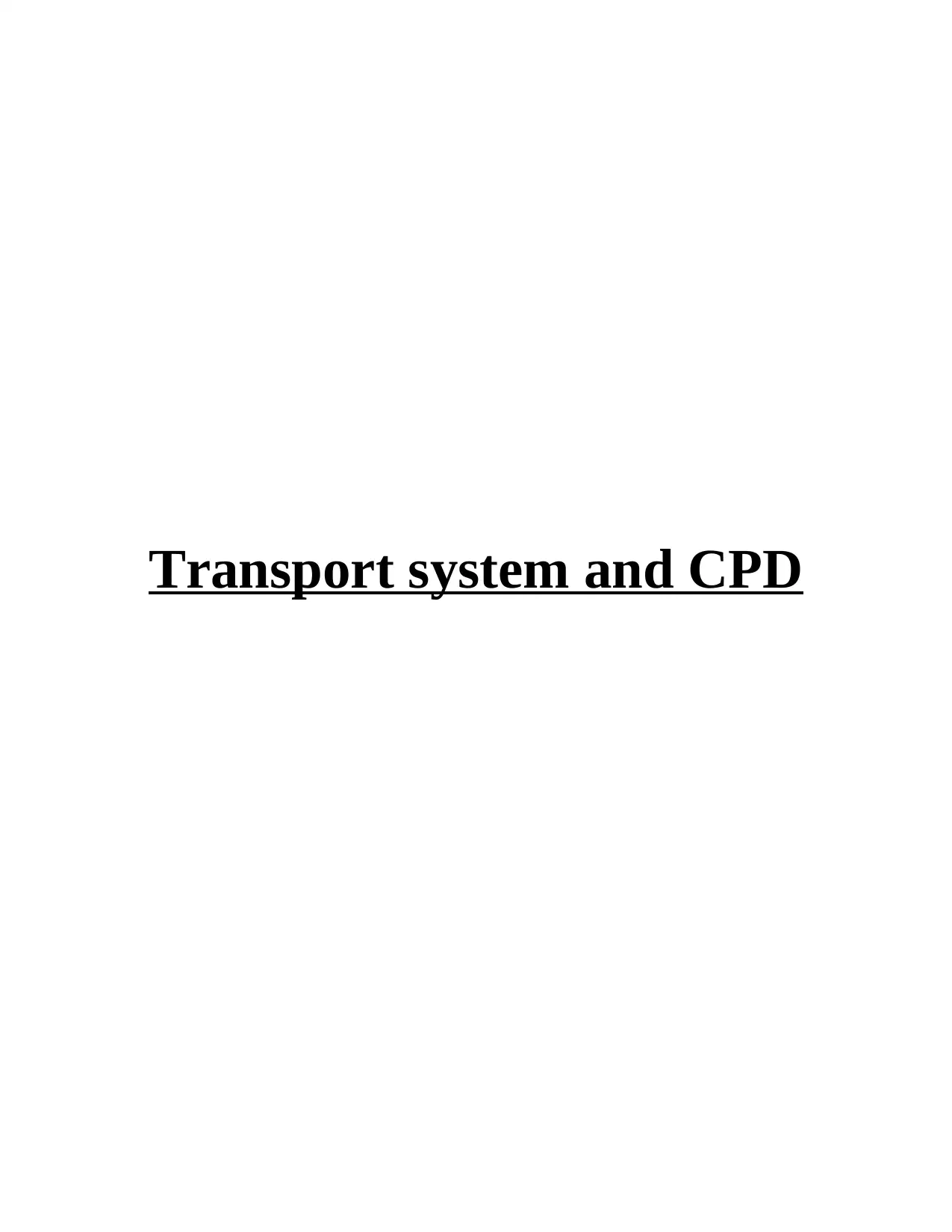
Transport system and CPD
Paraphrase This Document
Need a fresh take? Get an instant paraphrase of this document with our AI Paraphraser
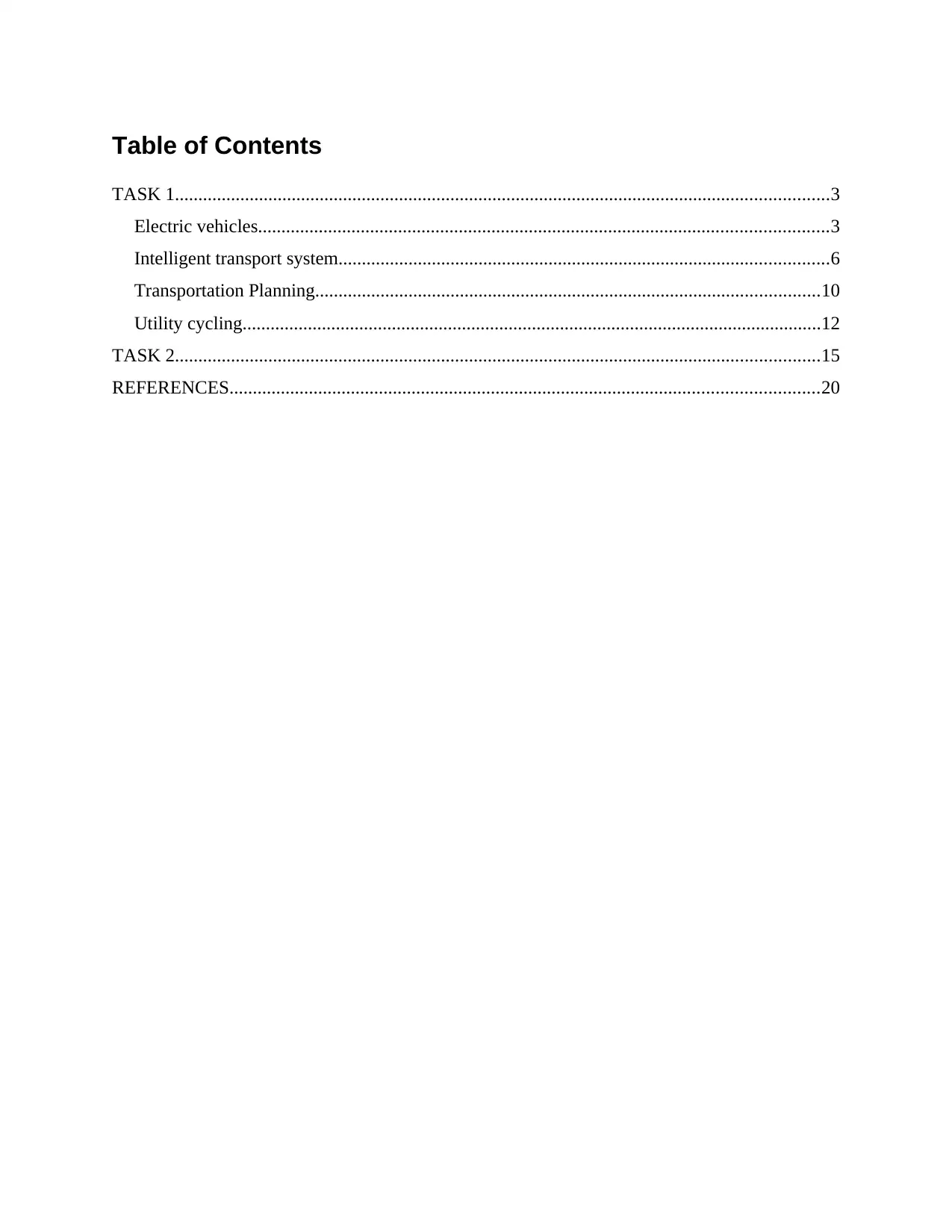
Table of Contents
TASK 1............................................................................................................................................3
Electric vehicles..........................................................................................................................3
Intelligent transport system.........................................................................................................6
Transportation Planning............................................................................................................10
Utility cycling............................................................................................................................12
TASK 2..........................................................................................................................................15
REFERENCES..............................................................................................................................20
TASK 1............................................................................................................................................3
Electric vehicles..........................................................................................................................3
Intelligent transport system.........................................................................................................6
Transportation Planning............................................................................................................10
Utility cycling............................................................................................................................12
TASK 2..........................................................................................................................................15
REFERENCES..............................................................................................................................20
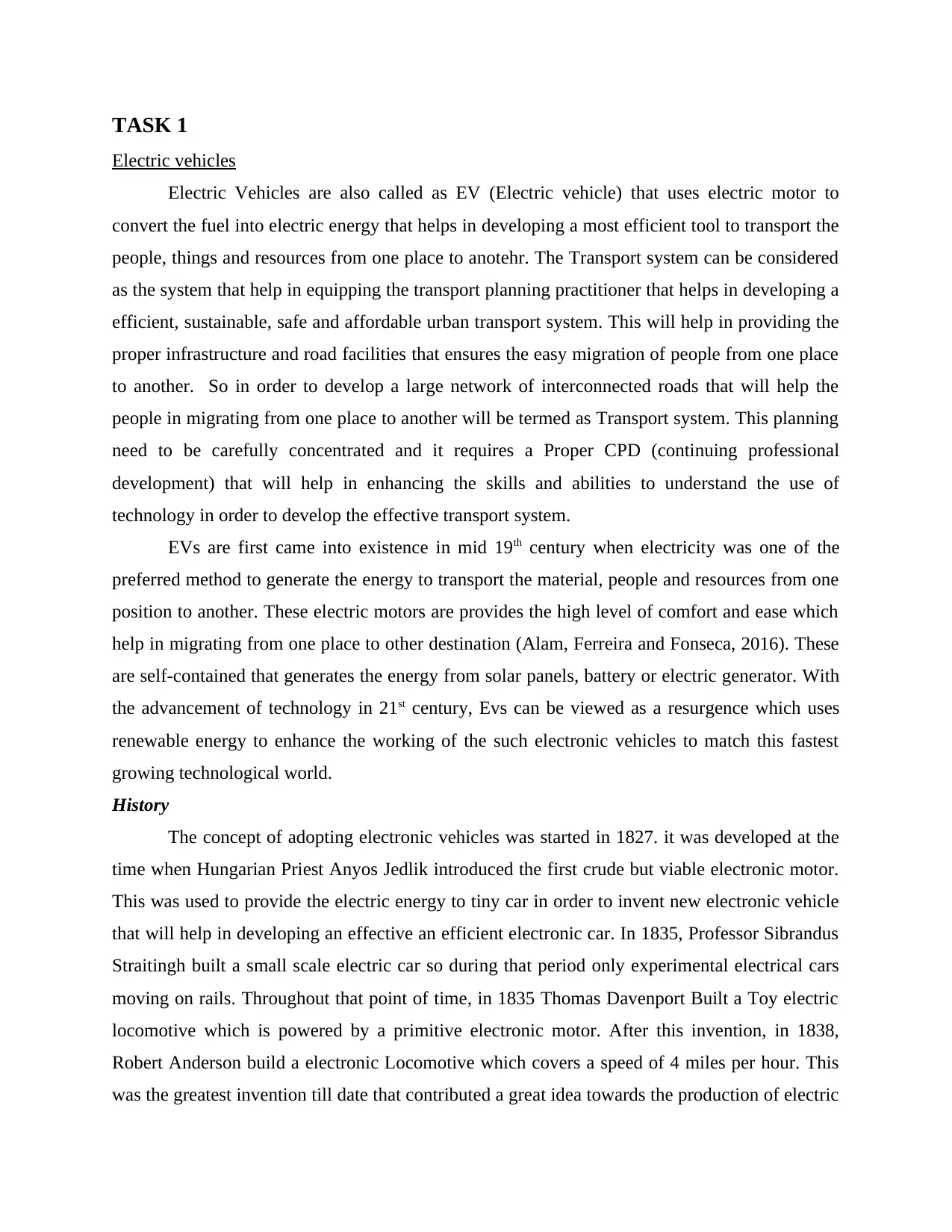
TASK 1
Electric vehicles
Electric Vehicles are also called as EV (Electric vehicle) that uses electric motor to
convert the fuel into electric energy that helps in developing a most efficient tool to transport the
people, things and resources from one place to anotehr. The Transport system can be considered
as the system that help in equipping the transport planning practitioner that helps in developing a
efficient, sustainable, safe and affordable urban transport system. This will help in providing the
proper infrastructure and road facilities that ensures the easy migration of people from one place
to another. So in order to develop a large network of interconnected roads that will help the
people in migrating from one place to another will be termed as Transport system. This planning
need to be carefully concentrated and it requires a Proper CPD (continuing professional
development) that will help in enhancing the skills and abilities to understand the use of
technology in order to develop the effective transport system.
EVs are first came into existence in mid 19th century when electricity was one of the
preferred method to generate the energy to transport the material, people and resources from one
position to another. These electric motors are provides the high level of comfort and ease which
help in migrating from one place to other destination (Alam, Ferreira and Fonseca, 2016). These
are self-contained that generates the energy from solar panels, battery or electric generator. With
the advancement of technology in 21st century, Evs can be viewed as a resurgence which uses
renewable energy to enhance the working of the such electronic vehicles to match this fastest
growing technological world.
History
The concept of adopting electronic vehicles was started in 1827. it was developed at the
time when Hungarian Priest Anyos Jedlik introduced the first crude but viable electronic motor.
This was used to provide the electric energy to tiny car in order to invent new electronic vehicle
that will help in developing an effective an efficient electronic car. In 1835, Professor Sibrandus
Straitingh built a small scale electric car so during that period only experimental electrical cars
moving on rails. Throughout that point of time, in 1835 Thomas Davenport Built a Toy electric
locomotive which is powered by a primitive electronic motor. After this invention, in 1838,
Robert Anderson build a electronic Locomotive which covers a speed of 4 miles per hour. This
was the greatest invention till date that contributed a great idea towards the production of electric
Electric vehicles
Electric Vehicles are also called as EV (Electric vehicle) that uses electric motor to
convert the fuel into electric energy that helps in developing a most efficient tool to transport the
people, things and resources from one place to anotehr. The Transport system can be considered
as the system that help in equipping the transport planning practitioner that helps in developing a
efficient, sustainable, safe and affordable urban transport system. This will help in providing the
proper infrastructure and road facilities that ensures the easy migration of people from one place
to another. So in order to develop a large network of interconnected roads that will help the
people in migrating from one place to another will be termed as Transport system. This planning
need to be carefully concentrated and it requires a Proper CPD (continuing professional
development) that will help in enhancing the skills and abilities to understand the use of
technology in order to develop the effective transport system.
EVs are first came into existence in mid 19th century when electricity was one of the
preferred method to generate the energy to transport the material, people and resources from one
position to another. These electric motors are provides the high level of comfort and ease which
help in migrating from one place to other destination (Alam, Ferreira and Fonseca, 2016). These
are self-contained that generates the energy from solar panels, battery or electric generator. With
the advancement of technology in 21st century, Evs can be viewed as a resurgence which uses
renewable energy to enhance the working of the such electronic vehicles to match this fastest
growing technological world.
History
The concept of adopting electronic vehicles was started in 1827. it was developed at the
time when Hungarian Priest Anyos Jedlik introduced the first crude but viable electronic motor.
This was used to provide the electric energy to tiny car in order to invent new electronic vehicle
that will help in developing an effective an efficient electronic car. In 1835, Professor Sibrandus
Straitingh built a small scale electric car so during that period only experimental electrical cars
moving on rails. Throughout that point of time, in 1835 Thomas Davenport Built a Toy electric
locomotive which is powered by a primitive electronic motor. After this invention, in 1838,
Robert Anderson build a electronic Locomotive which covers a speed of 4 miles per hour. This
was the greatest invention till date that contributed a great idea towards the production of electric
⊘ This is a preview!⊘
Do you want full access?
Subscribe today to unlock all pages.

Trusted by 1+ million students worldwide

vehicle with the advent of cheap assembly of line cars. There was a lack of storage batteries at
that time so it did not get much popularity whereas electric trains gained immense popularity due
to the achievement of fast speed and economies of invention. Initially electrified trains were
functioned with the use of the coal as motors did not uses oxygen in the mines. A number of
developments contributed to decline of electronic cars such as road infrastructure, use of
petroleum, etc. with the improvement of road infrastructure finally ICE cars were established to
which were provides more easy and vehicle to operate over long distances.
Experimentation
In January 1990, president of General motors introduced two seater EV concept which
had impacted greatly on the produced electronic cars that were already there to serve the large
number of people (Barfield and Dingus, 2014). Then the success of oil and auto industries were
the main reason behind the public acceptance of Evs. Experimentation of the effective and
affordable transporting tools helps in eliminating the the role of auto-mobile manufacturers that
uses oil, hydrogen and low powered batteries to limit the deployment and adoption of the
technology.
Sources to generate the Electricity in motorcars
There are many ways to to generate electricity which vary in cost, efficiency and
ecological desirability to establish an effective transport that sustains for the longer time period.
such sources are as follows:
Connection to generate plant- This can be termed as the direct connection that help in generating
the plants which is common among electronic trains, trolley buses, trucks etc. such vehicles
collect power from electric power strips which is mainly berried under road surface through the
use of electromagnetic induction
Onboard generator and Hybrid Evs: Generation of on-board using diesel engine that helps in
producing the diesel electric locomotive. A hybrid electrical vehicle combines a conventional
power train with some form of electric propulsion. In April, 2016 over 11 million hybrid electric
vehicles are sold after its inception in 1997. Japan is the leading seller of the world who have
sold almost 5 million hybrid Evs.
Advantages
Electric vehicles releases no tail pipe air pollutant at the place at the place where they are
generally operated (Engelbrecht and et.al., 2015). Such Evs generally generates less noise
that time so it did not get much popularity whereas electric trains gained immense popularity due
to the achievement of fast speed and economies of invention. Initially electrified trains were
functioned with the use of the coal as motors did not uses oxygen in the mines. A number of
developments contributed to decline of electronic cars such as road infrastructure, use of
petroleum, etc. with the improvement of road infrastructure finally ICE cars were established to
which were provides more easy and vehicle to operate over long distances.
Experimentation
In January 1990, president of General motors introduced two seater EV concept which
had impacted greatly on the produced electronic cars that were already there to serve the large
number of people (Barfield and Dingus, 2014). Then the success of oil and auto industries were
the main reason behind the public acceptance of Evs. Experimentation of the effective and
affordable transporting tools helps in eliminating the the role of auto-mobile manufacturers that
uses oil, hydrogen and low powered batteries to limit the deployment and adoption of the
technology.
Sources to generate the Electricity in motorcars
There are many ways to to generate electricity which vary in cost, efficiency and
ecological desirability to establish an effective transport that sustains for the longer time period.
such sources are as follows:
Connection to generate plant- This can be termed as the direct connection that help in generating
the plants which is common among electronic trains, trolley buses, trucks etc. such vehicles
collect power from electric power strips which is mainly berried under road surface through the
use of electromagnetic induction
Onboard generator and Hybrid Evs: Generation of on-board using diesel engine that helps in
producing the diesel electric locomotive. A hybrid electrical vehicle combines a conventional
power train with some form of electric propulsion. In April, 2016 over 11 million hybrid electric
vehicles are sold after its inception in 1997. Japan is the leading seller of the world who have
sold almost 5 million hybrid Evs.
Advantages
Electric vehicles releases no tail pipe air pollutant at the place at the place where they are
generally operated (Engelbrecht and et.al., 2015). Such Evs generally generates less noise
Paraphrase This Document
Need a fresh take? Get an instant paraphrase of this document with our AI Paraphraser
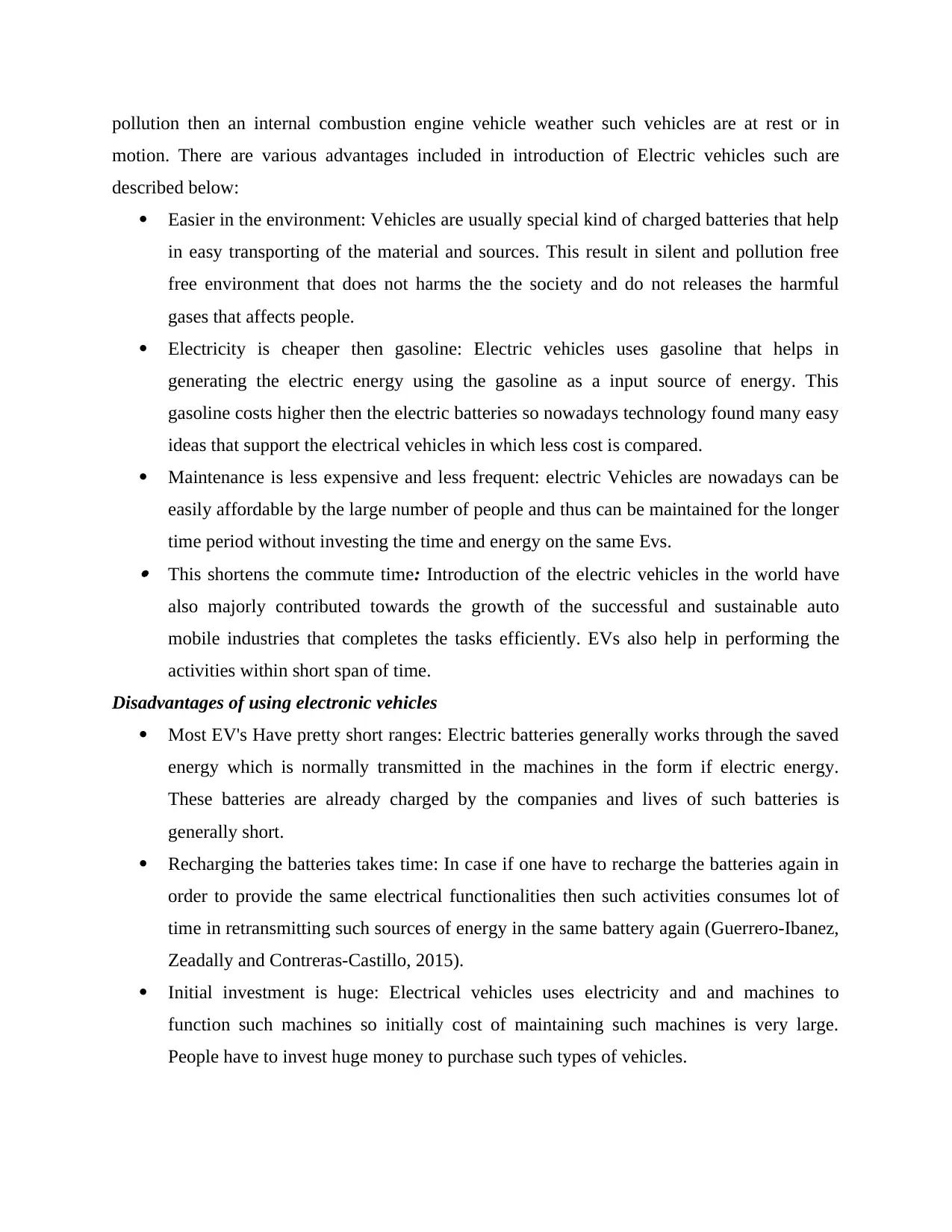
pollution then an internal combustion engine vehicle weather such vehicles are at rest or in
motion. There are various advantages included in introduction of Electric vehicles such are
described below:
Easier in the environment: Vehicles are usually special kind of charged batteries that help
in easy transporting of the material and sources. This result in silent and pollution free
free environment that does not harms the the society and do not releases the harmful
gases that affects people.
Electricity is cheaper then gasoline: Electric vehicles uses gasoline that helps in
generating the electric energy using the gasoline as a input source of energy. This
gasoline costs higher then the electric batteries so nowadays technology found many easy
ideas that support the electrical vehicles in which less cost is compared.
Maintenance is less expensive and less frequent: electric Vehicles are nowadays can be
easily affordable by the large number of people and thus can be maintained for the longer
time period without investing the time and energy on the same Evs. This shortens the commute time: Introduction of the electric vehicles in the world have
also majorly contributed towards the growth of the successful and sustainable auto
mobile industries that completes the tasks efficiently. EVs also help in performing the
activities within short span of time.
Disadvantages of using electronic vehicles
Most EV's Have pretty short ranges: Electric batteries generally works through the saved
energy which is normally transmitted in the machines in the form if electric energy.
These batteries are already charged by the companies and lives of such batteries is
generally short.
Recharging the batteries takes time: In case if one have to recharge the batteries again in
order to provide the same electrical functionalities then such activities consumes lot of
time in retransmitting such sources of energy in the same battery again (Guerrero-Ibanez,
Zeadally and Contreras-Castillo, 2015).
Initial investment is huge: Electrical vehicles uses electricity and and machines to
function such machines so initially cost of maintaining such machines is very large.
People have to invest huge money to purchase such types of vehicles.
motion. There are various advantages included in introduction of Electric vehicles such are
described below:
Easier in the environment: Vehicles are usually special kind of charged batteries that help
in easy transporting of the material and sources. This result in silent and pollution free
free environment that does not harms the the society and do not releases the harmful
gases that affects people.
Electricity is cheaper then gasoline: Electric vehicles uses gasoline that helps in
generating the electric energy using the gasoline as a input source of energy. This
gasoline costs higher then the electric batteries so nowadays technology found many easy
ideas that support the electrical vehicles in which less cost is compared.
Maintenance is less expensive and less frequent: electric Vehicles are nowadays can be
easily affordable by the large number of people and thus can be maintained for the longer
time period without investing the time and energy on the same Evs. This shortens the commute time: Introduction of the electric vehicles in the world have
also majorly contributed towards the growth of the successful and sustainable auto
mobile industries that completes the tasks efficiently. EVs also help in performing the
activities within short span of time.
Disadvantages of using electronic vehicles
Most EV's Have pretty short ranges: Electric batteries generally works through the saved
energy which is normally transmitted in the machines in the form if electric energy.
These batteries are already charged by the companies and lives of such batteries is
generally short.
Recharging the batteries takes time: In case if one have to recharge the batteries again in
order to provide the same electrical functionalities then such activities consumes lot of
time in retransmitting such sources of energy in the same battery again (Guerrero-Ibanez,
Zeadally and Contreras-Castillo, 2015).
Initial investment is huge: Electrical vehicles uses electricity and and machines to
function such machines so initially cost of maintaining such machines is very large.
People have to invest huge money to purchase such types of vehicles.
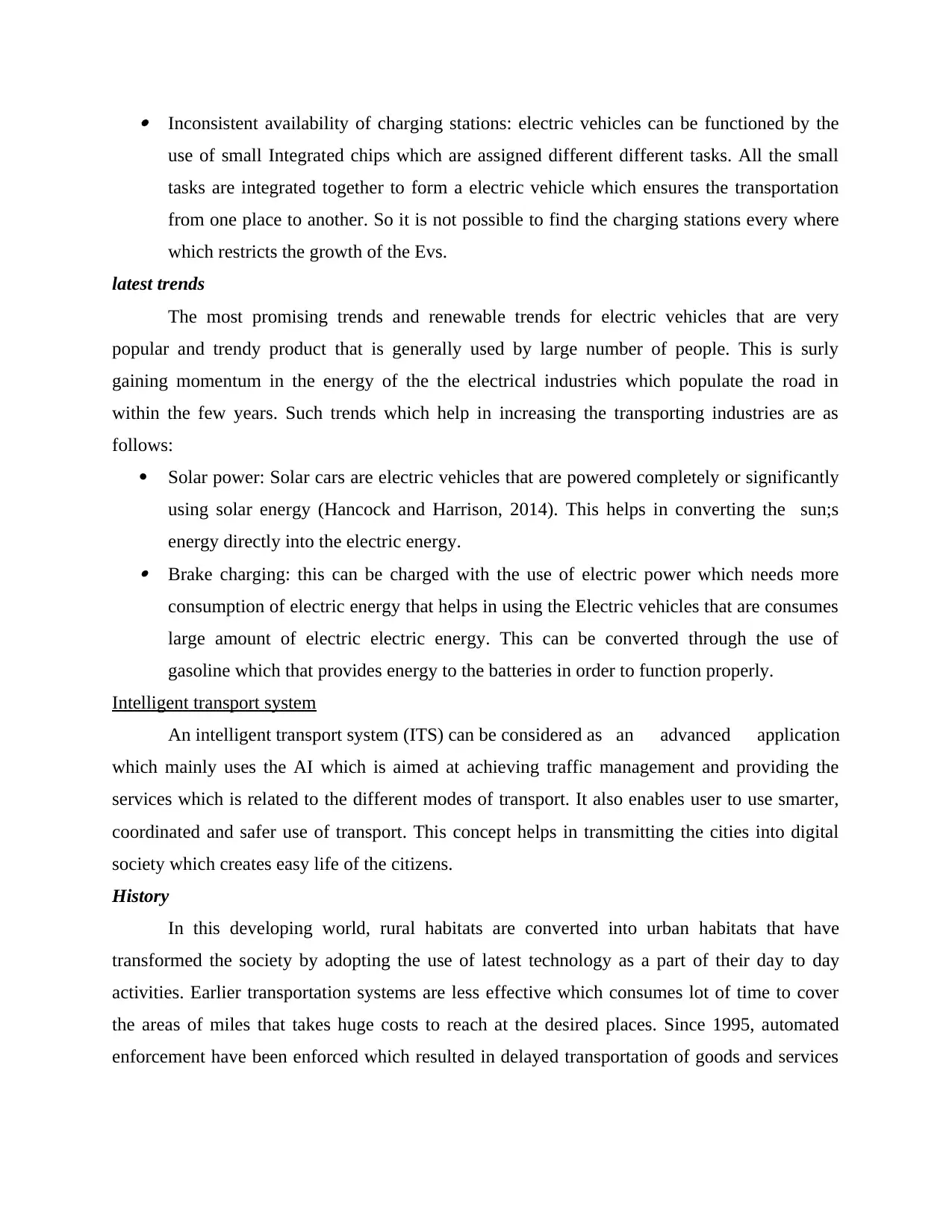
Inconsistent availability of charging stations: electric vehicles can be functioned by the
use of small Integrated chips which are assigned different different tasks. All the small
tasks are integrated together to form a electric vehicle which ensures the transportation
from one place to another. So it is not possible to find the charging stations every where
which restricts the growth of the Evs.
latest trends
The most promising trends and renewable trends for electric vehicles that are very
popular and trendy product that is generally used by large number of people. This is surly
gaining momentum in the energy of the the electrical industries which populate the road in
within the few years. Such trends which help in increasing the transporting industries are as
follows:
Solar power: Solar cars are electric vehicles that are powered completely or significantly
using solar energy (Hancock and Harrison, 2014). This helps in converting the sun;s
energy directly into the electric energy. Brake charging: this can be charged with the use of electric power which needs more
consumption of electric energy that helps in using the Electric vehicles that are consumes
large amount of electric electric energy. This can be converted through the use of
gasoline which that provides energy to the batteries in order to function properly.
Intelligent transport system
An intelligent transport system (ITS) can be considered as an advanced application
which mainly uses the AI which is aimed at achieving traffic management and providing the
services which is related to the different modes of transport. It also enables user to use smarter,
coordinated and safer use of transport. This concept helps in transmitting the cities into digital
society which creates easy life of the citizens.
History
In this developing world, rural habitats are converted into urban habitats that have
transformed the society by adopting the use of latest technology as a part of their day to day
activities. Earlier transportation systems are less effective which consumes lot of time to cover
the areas of miles that takes huge costs to reach at the desired places. Since 1995, automated
enforcement have been enforced which resulted in delayed transportation of goods and services
use of small Integrated chips which are assigned different different tasks. All the small
tasks are integrated together to form a electric vehicle which ensures the transportation
from one place to another. So it is not possible to find the charging stations every where
which restricts the growth of the Evs.
latest trends
The most promising trends and renewable trends for electric vehicles that are very
popular and trendy product that is generally used by large number of people. This is surly
gaining momentum in the energy of the the electrical industries which populate the road in
within the few years. Such trends which help in increasing the transporting industries are as
follows:
Solar power: Solar cars are electric vehicles that are powered completely or significantly
using solar energy (Hancock and Harrison, 2014). This helps in converting the sun;s
energy directly into the electric energy. Brake charging: this can be charged with the use of electric power which needs more
consumption of electric energy that helps in using the Electric vehicles that are consumes
large amount of electric electric energy. This can be converted through the use of
gasoline which that provides energy to the batteries in order to function properly.
Intelligent transport system
An intelligent transport system (ITS) can be considered as an advanced application
which mainly uses the AI which is aimed at achieving traffic management and providing the
services which is related to the different modes of transport. It also enables user to use smarter,
coordinated and safer use of transport. This concept helps in transmitting the cities into digital
society which creates easy life of the citizens.
History
In this developing world, rural habitats are converted into urban habitats that have
transformed the society by adopting the use of latest technology as a part of their day to day
activities. Earlier transportation systems are less effective which consumes lot of time to cover
the areas of miles that takes huge costs to reach at the desired places. Since 1995, automated
enforcement have been enforced which resulted in delayed transportation of goods and services
⊘ This is a preview!⊘
Do you want full access?
Subscribe today to unlock all pages.

Trusted by 1+ million students worldwide
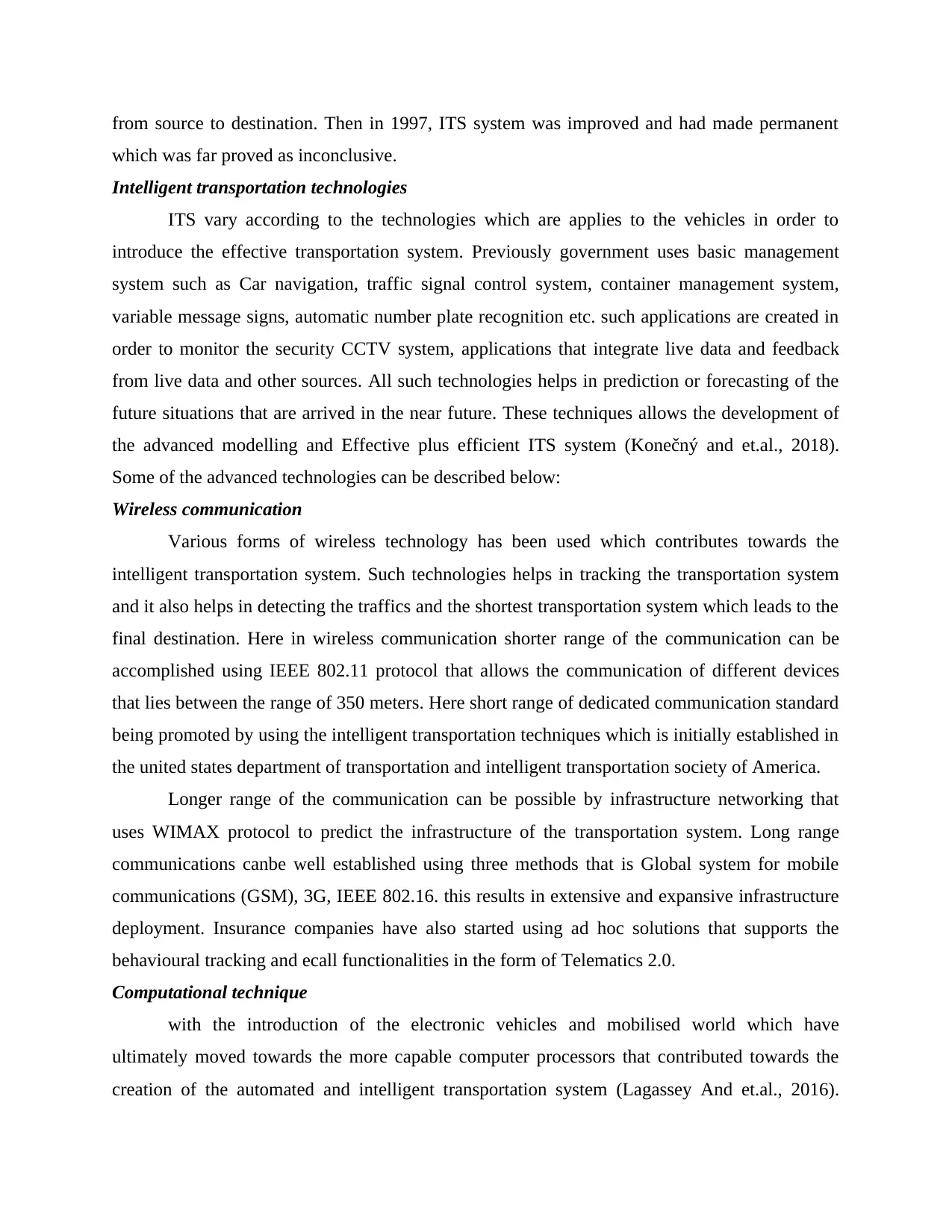
from source to destination. Then in 1997, ITS system was improved and had made permanent
which was far proved as inconclusive.
Intelligent transportation technologies
ITS vary according to the technologies which are applies to the vehicles in order to
introduce the effective transportation system. Previously government uses basic management
system such as Car navigation, traffic signal control system, container management system,
variable message signs, automatic number plate recognition etc. such applications are created in
order to monitor the security CCTV system, applications that integrate live data and feedback
from live data and other sources. All such technologies helps in prediction or forecasting of the
future situations that are arrived in the near future. These techniques allows the development of
the advanced modelling and Effective plus efficient ITS system (Konečný and et.al., 2018).
Some of the advanced technologies can be described below:
Wireless communication
Various forms of wireless technology has been used which contributes towards the
intelligent transportation system. Such technologies helps in tracking the transportation system
and it also helps in detecting the traffics and the shortest transportation system which leads to the
final destination. Here in wireless communication shorter range of the communication can be
accomplished using IEEE 802.11 protocol that allows the communication of different devices
that lies between the range of 350 meters. Here short range of dedicated communication standard
being promoted by using the intelligent transportation techniques which is initially established in
the united states department of transportation and intelligent transportation society of America.
Longer range of the communication can be possible by infrastructure networking that
uses WIMAX protocol to predict the infrastructure of the transportation system. Long range
communications canbe well established using three methods that is Global system for mobile
communications (GSM), 3G, IEEE 802.16. this results in extensive and expansive infrastructure
deployment. Insurance companies have also started using ad hoc solutions that supports the
behavioural tracking and ecall functionalities in the form of Telematics 2.0.
Computational technique
with the introduction of the electronic vehicles and mobilised world which have
ultimately moved towards the more capable computer processors that contributed towards the
creation of the automated and intelligent transportation system (Lagassey And et.al., 2016).
which was far proved as inconclusive.
Intelligent transportation technologies
ITS vary according to the technologies which are applies to the vehicles in order to
introduce the effective transportation system. Previously government uses basic management
system such as Car navigation, traffic signal control system, container management system,
variable message signs, automatic number plate recognition etc. such applications are created in
order to monitor the security CCTV system, applications that integrate live data and feedback
from live data and other sources. All such technologies helps in prediction or forecasting of the
future situations that are arrived in the near future. These techniques allows the development of
the advanced modelling and Effective plus efficient ITS system (Konečný and et.al., 2018).
Some of the advanced technologies can be described below:
Wireless communication
Various forms of wireless technology has been used which contributes towards the
intelligent transportation system. Such technologies helps in tracking the transportation system
and it also helps in detecting the traffics and the shortest transportation system which leads to the
final destination. Here in wireless communication shorter range of the communication can be
accomplished using IEEE 802.11 protocol that allows the communication of different devices
that lies between the range of 350 meters. Here short range of dedicated communication standard
being promoted by using the intelligent transportation techniques which is initially established in
the united states department of transportation and intelligent transportation society of America.
Longer range of the communication can be possible by infrastructure networking that
uses WIMAX protocol to predict the infrastructure of the transportation system. Long range
communications canbe well established using three methods that is Global system for mobile
communications (GSM), 3G, IEEE 802.16. this results in extensive and expansive infrastructure
deployment. Insurance companies have also started using ad hoc solutions that supports the
behavioural tracking and ecall functionalities in the form of Telematics 2.0.
Computational technique
with the introduction of the electronic vehicles and mobilised world which have
ultimately moved towards the more capable computer processors that contributed towards the
creation of the automated and intelligent transportation system (Lagassey And et.al., 2016).
Paraphrase This Document
Need a fresh take? Get an instant paraphrase of this document with our AI Paraphraser
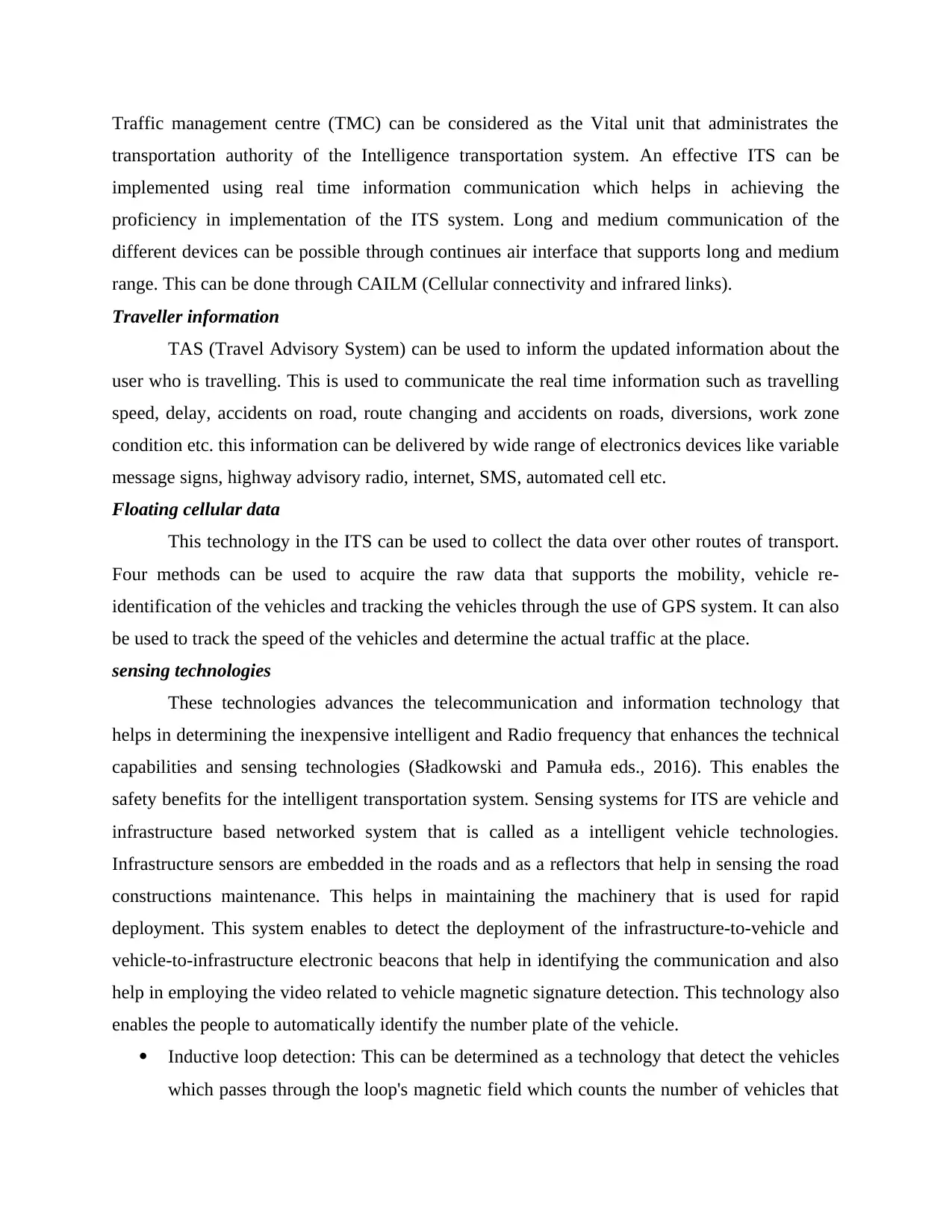
Traffic management centre (TMC) can be considered as the Vital unit that administrates the
transportation authority of the Intelligence transportation system. An effective ITS can be
implemented using real time information communication which helps in achieving the
proficiency in implementation of the ITS system. Long and medium communication of the
different devices can be possible through continues air interface that supports long and medium
range. This can be done through CAILM (Cellular connectivity and infrared links).
Traveller information
TAS (Travel Advisory System) can be used to inform the updated information about the
user who is travelling. This is used to communicate the real time information such as travelling
speed, delay, accidents on road, route changing and accidents on roads, diversions, work zone
condition etc. this information can be delivered by wide range of electronics devices like variable
message signs, highway advisory radio, internet, SMS, automated cell etc.
Floating cellular data
This technology in the ITS can be used to collect the data over other routes of transport.
Four methods can be used to acquire the raw data that supports the mobility, vehicle re-
identification of the vehicles and tracking the vehicles through the use of GPS system. It can also
be used to track the speed of the vehicles and determine the actual traffic at the place.
sensing technologies
These technologies advances the telecommunication and information technology that
helps in determining the inexpensive intelligent and Radio frequency that enhances the technical
capabilities and sensing technologies (Sładkowski and Pamuła eds., 2016). This enables the
safety benefits for the intelligent transportation system. Sensing systems for ITS are vehicle and
infrastructure based networked system that is called as a intelligent vehicle technologies.
Infrastructure sensors are embedded in the roads and as a reflectors that help in sensing the road
constructions maintenance. This helps in maintaining the machinery that is used for rapid
deployment. This system enables to detect the deployment of the infrastructure-to-vehicle and
vehicle-to-infrastructure electronic beacons that help in identifying the communication and also
help in employing the video related to vehicle magnetic signature detection. This technology also
enables the people to automatically identify the number plate of the vehicle.
Inductive loop detection: This can be determined as a technology that detect the vehicles
which passes through the loop's magnetic field which counts the number of vehicles that
transportation authority of the Intelligence transportation system. An effective ITS can be
implemented using real time information communication which helps in achieving the
proficiency in implementation of the ITS system. Long and medium communication of the
different devices can be possible through continues air interface that supports long and medium
range. This can be done through CAILM (Cellular connectivity and infrared links).
Traveller information
TAS (Travel Advisory System) can be used to inform the updated information about the
user who is travelling. This is used to communicate the real time information such as travelling
speed, delay, accidents on road, route changing and accidents on roads, diversions, work zone
condition etc. this information can be delivered by wide range of electronics devices like variable
message signs, highway advisory radio, internet, SMS, automated cell etc.
Floating cellular data
This technology in the ITS can be used to collect the data over other routes of transport.
Four methods can be used to acquire the raw data that supports the mobility, vehicle re-
identification of the vehicles and tracking the vehicles through the use of GPS system. It can also
be used to track the speed of the vehicles and determine the actual traffic at the place.
sensing technologies
These technologies advances the telecommunication and information technology that
helps in determining the inexpensive intelligent and Radio frequency that enhances the technical
capabilities and sensing technologies (Sładkowski and Pamuła eds., 2016). This enables the
safety benefits for the intelligent transportation system. Sensing systems for ITS are vehicle and
infrastructure based networked system that is called as a intelligent vehicle technologies.
Infrastructure sensors are embedded in the roads and as a reflectors that help in sensing the road
constructions maintenance. This helps in maintaining the machinery that is used for rapid
deployment. This system enables to detect the deployment of the infrastructure-to-vehicle and
vehicle-to-infrastructure electronic beacons that help in identifying the communication and also
help in employing the video related to vehicle magnetic signature detection. This technology also
enables the people to automatically identify the number plate of the vehicle.
Inductive loop detection: This can be determined as a technology that detect the vehicles
which passes through the loop's magnetic field which counts the number of vehicles that
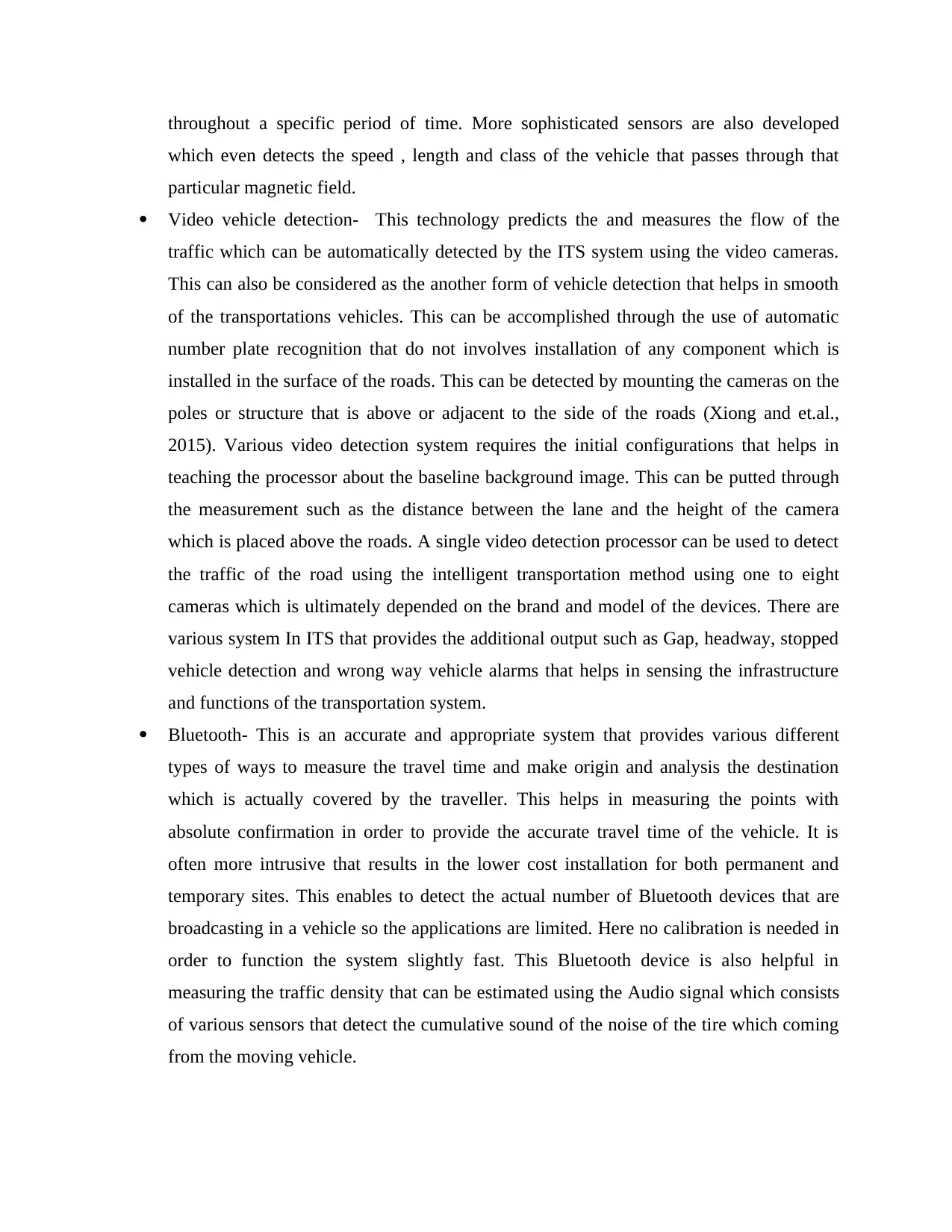
throughout a specific period of time. More sophisticated sensors are also developed
which even detects the speed , length and class of the vehicle that passes through that
particular magnetic field.
Video vehicle detection- This technology predicts the and measures the flow of the
traffic which can be automatically detected by the ITS system using the video cameras.
This can also be considered as the another form of vehicle detection that helps in smooth
of the transportations vehicles. This can be accomplished through the use of automatic
number plate recognition that do not involves installation of any component which is
installed in the surface of the roads. This can be detected by mounting the cameras on the
poles or structure that is above or adjacent to the side of the roads (Xiong and et.al.,
2015). Various video detection system requires the initial configurations that helps in
teaching the processor about the baseline background image. This can be putted through
the measurement such as the distance between the lane and the height of the camera
which is placed above the roads. A single video detection processor can be used to detect
the traffic of the road using the intelligent transportation method using one to eight
cameras which is ultimately depended on the brand and model of the devices. There are
various system In ITS that provides the additional output such as Gap, headway, stopped
vehicle detection and wrong way vehicle alarms that helps in sensing the infrastructure
and functions of the transportation system.
Bluetooth- This is an accurate and appropriate system that provides various different
types of ways to measure the travel time and make origin and analysis the destination
which is actually covered by the traveller. This helps in measuring the points with
absolute confirmation in order to provide the accurate travel time of the vehicle. It is
often more intrusive that results in the lower cost installation for both permanent and
temporary sites. This enables to detect the actual number of Bluetooth devices that are
broadcasting in a vehicle so the applications are limited. Here no calibration is needed in
order to function the system slightly fast. This Bluetooth device is also helpful in
measuring the traffic density that can be estimated using the Audio signal which consists
of various sensors that detect the cumulative sound of the noise of the tire which coming
from the moving vehicle.
which even detects the speed , length and class of the vehicle that passes through that
particular magnetic field.
Video vehicle detection- This technology predicts the and measures the flow of the
traffic which can be automatically detected by the ITS system using the video cameras.
This can also be considered as the another form of vehicle detection that helps in smooth
of the transportations vehicles. This can be accomplished through the use of automatic
number plate recognition that do not involves installation of any component which is
installed in the surface of the roads. This can be detected by mounting the cameras on the
poles or structure that is above or adjacent to the side of the roads (Xiong and et.al.,
2015). Various video detection system requires the initial configurations that helps in
teaching the processor about the baseline background image. This can be putted through
the measurement such as the distance between the lane and the height of the camera
which is placed above the roads. A single video detection processor can be used to detect
the traffic of the road using the intelligent transportation method using one to eight
cameras which is ultimately depended on the brand and model of the devices. There are
various system In ITS that provides the additional output such as Gap, headway, stopped
vehicle detection and wrong way vehicle alarms that helps in sensing the infrastructure
and functions of the transportation system.
Bluetooth- This is an accurate and appropriate system that provides various different
types of ways to measure the travel time and make origin and analysis the destination
which is actually covered by the traveller. This helps in measuring the points with
absolute confirmation in order to provide the accurate travel time of the vehicle. It is
often more intrusive that results in the lower cost installation for both permanent and
temporary sites. This enables to detect the actual number of Bluetooth devices that are
broadcasting in a vehicle so the applications are limited. Here no calibration is needed in
order to function the system slightly fast. This Bluetooth device is also helpful in
measuring the traffic density that can be estimated using the Audio signal which consists
of various sensors that detect the cumulative sound of the noise of the tire which coming
from the moving vehicle.
⊘ This is a preview!⊘
Do you want full access?
Subscribe today to unlock all pages.

Trusted by 1+ million students worldwide
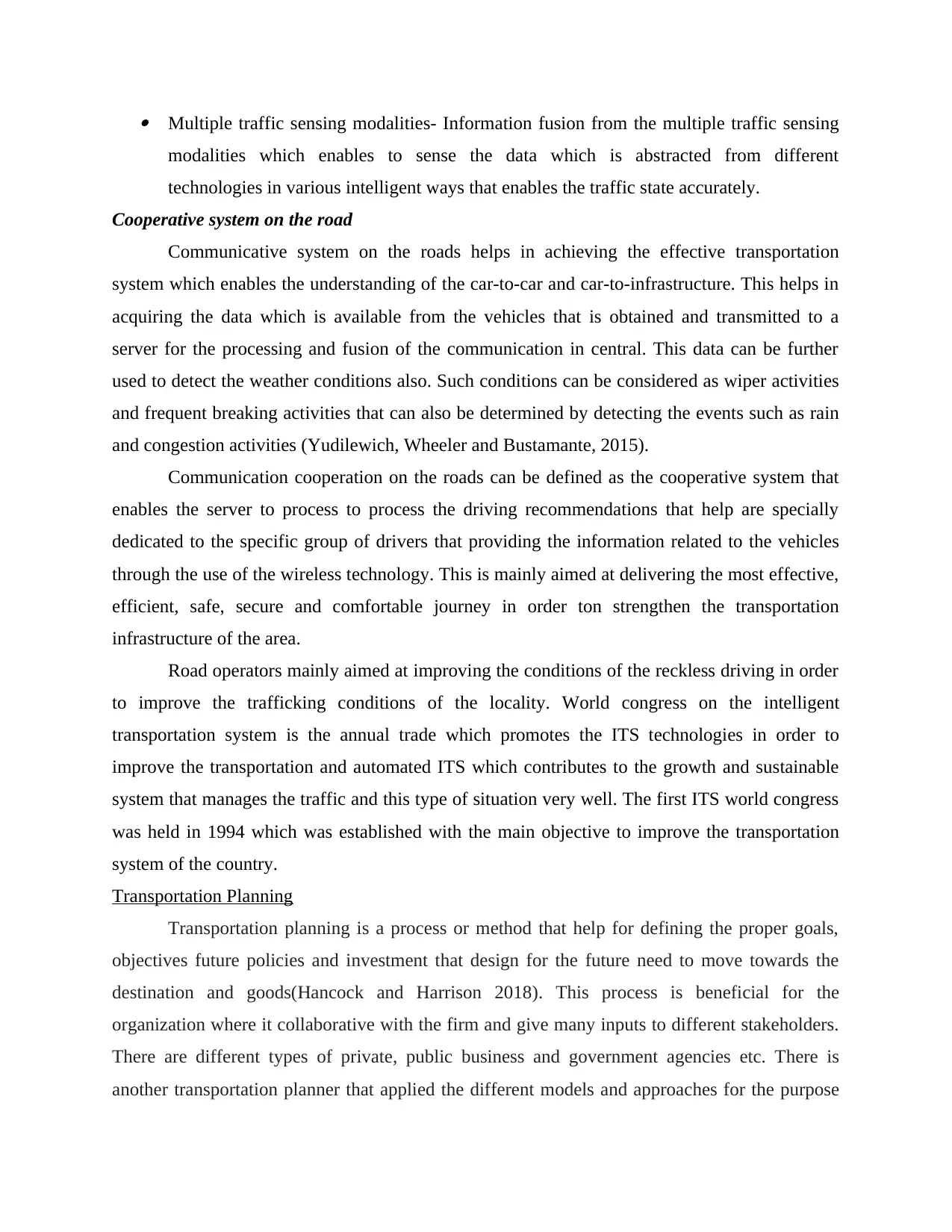
Multiple traffic sensing modalities- Information fusion from the multiple traffic sensing
modalities which enables to sense the data which is abstracted from different
technologies in various intelligent ways that enables the traffic state accurately.
Cooperative system on the road
Communicative system on the roads helps in achieving the effective transportation
system which enables the understanding of the car-to-car and car-to-infrastructure. This helps in
acquiring the data which is available from the vehicles that is obtained and transmitted to a
server for the processing and fusion of the communication in central. This data can be further
used to detect the weather conditions also. Such conditions can be considered as wiper activities
and frequent breaking activities that can also be determined by detecting the events such as rain
and congestion activities (Yudilewich, Wheeler and Bustamante, 2015).
Communication cooperation on the roads can be defined as the cooperative system that
enables the server to process to process the driving recommendations that help are specially
dedicated to the specific group of drivers that providing the information related to the vehicles
through the use of the wireless technology. This is mainly aimed at delivering the most effective,
efficient, safe, secure and comfortable journey in order ton strengthen the transportation
infrastructure of the area.
Road operators mainly aimed at improving the conditions of the reckless driving in order
to improve the trafficking conditions of the locality. World congress on the intelligent
transportation system is the annual trade which promotes the ITS technologies in order to
improve the transportation and automated ITS which contributes to the growth and sustainable
system that manages the traffic and this type of situation very well. The first ITS world congress
was held in 1994 which was established with the main objective to improve the transportation
system of the country.
Transportation Planning
Transportation planning is a process or method that help for defining the proper goals,
objectives future policies and investment that design for the future need to move towards the
destination and goods(Hancock and Harrison 2018). This process is beneficial for the
organization where it collaborative with the firm and give many inputs to different stakeholders.
There are different types of private, public business and government agencies etc. There is
another transportation planner that applied the different models and approaches for the purpose
modalities which enables to sense the data which is abstracted from different
technologies in various intelligent ways that enables the traffic state accurately.
Cooperative system on the road
Communicative system on the roads helps in achieving the effective transportation
system which enables the understanding of the car-to-car and car-to-infrastructure. This helps in
acquiring the data which is available from the vehicles that is obtained and transmitted to a
server for the processing and fusion of the communication in central. This data can be further
used to detect the weather conditions also. Such conditions can be considered as wiper activities
and frequent breaking activities that can also be determined by detecting the events such as rain
and congestion activities (Yudilewich, Wheeler and Bustamante, 2015).
Communication cooperation on the roads can be defined as the cooperative system that
enables the server to process to process the driving recommendations that help are specially
dedicated to the specific group of drivers that providing the information related to the vehicles
through the use of the wireless technology. This is mainly aimed at delivering the most effective,
efficient, safe, secure and comfortable journey in order ton strengthen the transportation
infrastructure of the area.
Road operators mainly aimed at improving the conditions of the reckless driving in order
to improve the trafficking conditions of the locality. World congress on the intelligent
transportation system is the annual trade which promotes the ITS technologies in order to
improve the transportation and automated ITS which contributes to the growth and sustainable
system that manages the traffic and this type of situation very well. The first ITS world congress
was held in 1994 which was established with the main objective to improve the transportation
system of the country.
Transportation Planning
Transportation planning is a process or method that help for defining the proper goals,
objectives future policies and investment that design for the future need to move towards the
destination and goods(Hancock and Harrison 2018). This process is beneficial for the
organization where it collaborative with the firm and give many inputs to different stakeholders.
There are different types of private, public business and government agencies etc. There is
another transportation planner that applied the different models and approaches for the purpose
Paraphrase This Document
Need a fresh take? Get an instant paraphrase of this document with our AI Paraphraser
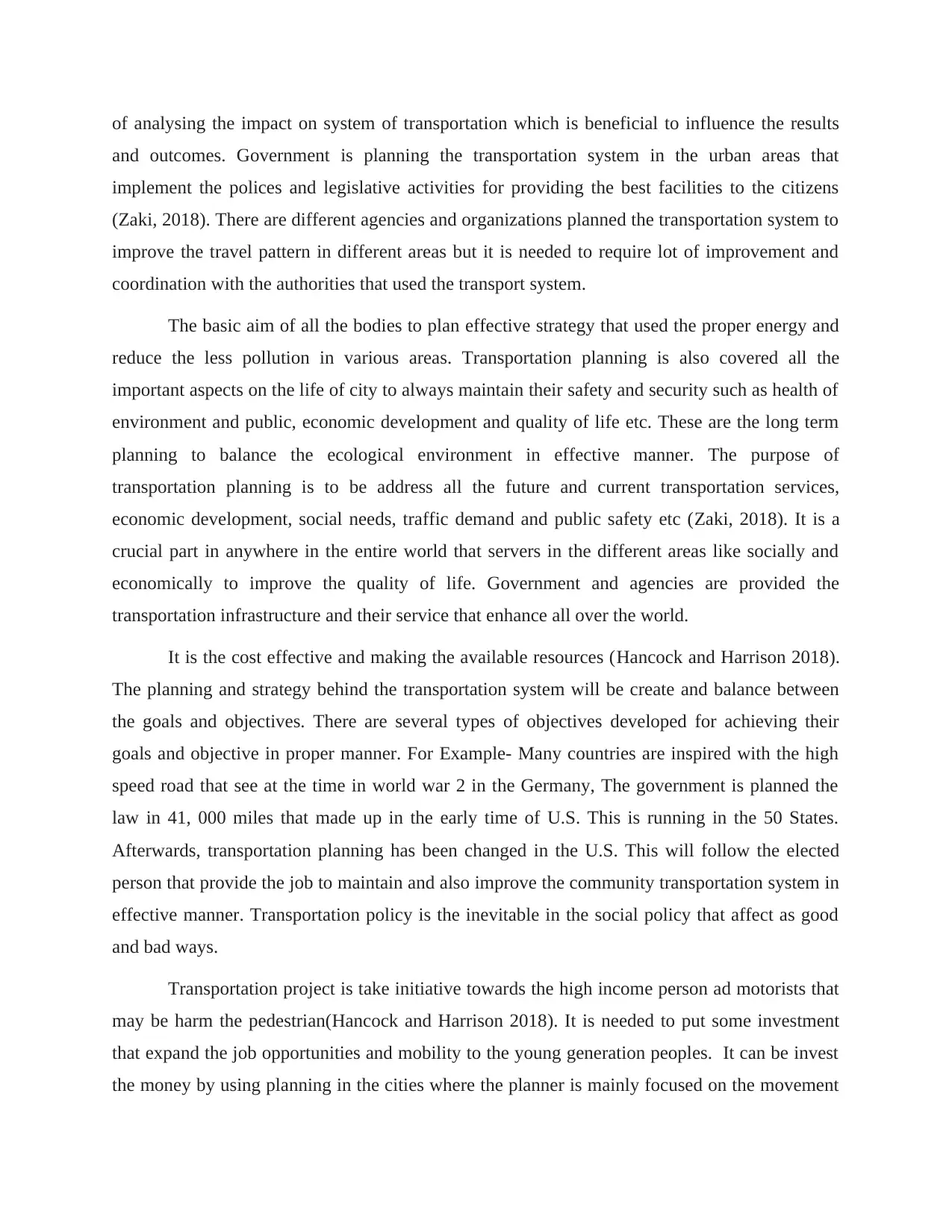
of analysing the impact on system of transportation which is beneficial to influence the results
and outcomes. Government is planning the transportation system in the urban areas that
implement the polices and legislative activities for providing the best facilities to the citizens
(Zaki, 2018). There are different agencies and organizations planned the transportation system to
improve the travel pattern in different areas but it is needed to require lot of improvement and
coordination with the authorities that used the transport system.
The basic aim of all the bodies to plan effective strategy that used the proper energy and
reduce the less pollution in various areas. Transportation planning is also covered all the
important aspects on the life of city to always maintain their safety and security such as health of
environment and public, economic development and quality of life etc. These are the long term
planning to balance the ecological environment in effective manner. The purpose of
transportation planning is to be address all the future and current transportation services,
economic development, social needs, traffic demand and public safety etc (Zaki, 2018). It is a
crucial part in anywhere in the entire world that servers in the different areas like socially and
economically to improve the quality of life. Government and agencies are provided the
transportation infrastructure and their service that enhance all over the world.
It is the cost effective and making the available resources (Hancock and Harrison 2018).
The planning and strategy behind the transportation system will be create and balance between
the goals and objectives. There are several types of objectives developed for achieving their
goals and objective in proper manner. For Example- Many countries are inspired with the high
speed road that see at the time in world war 2 in the Germany, The government is planned the
law in 41, 000 miles that made up in the early time of U.S. This is running in the 50 States.
Afterwards, transportation planning has been changed in the U.S. This will follow the elected
person that provide the job to maintain and also improve the community transportation system in
effective manner. Transportation policy is the inevitable in the social policy that affect as good
and bad ways.
Transportation project is take initiative towards the high income person ad motorists that
may be harm the pedestrian(Hancock and Harrison 2018). It is needed to put some investment
that expand the job opportunities and mobility to the young generation peoples. It can be invest
the money by using planning in the cities where the planner is mainly focused on the movement
and outcomes. Government is planning the transportation system in the urban areas that
implement the polices and legislative activities for providing the best facilities to the citizens
(Zaki, 2018). There are different agencies and organizations planned the transportation system to
improve the travel pattern in different areas but it is needed to require lot of improvement and
coordination with the authorities that used the transport system.
The basic aim of all the bodies to plan effective strategy that used the proper energy and
reduce the less pollution in various areas. Transportation planning is also covered all the
important aspects on the life of city to always maintain their safety and security such as health of
environment and public, economic development and quality of life etc. These are the long term
planning to balance the ecological environment in effective manner. The purpose of
transportation planning is to be address all the future and current transportation services,
economic development, social needs, traffic demand and public safety etc (Zaki, 2018). It is a
crucial part in anywhere in the entire world that servers in the different areas like socially and
economically to improve the quality of life. Government and agencies are provided the
transportation infrastructure and their service that enhance all over the world.
It is the cost effective and making the available resources (Hancock and Harrison 2018).
The planning and strategy behind the transportation system will be create and balance between
the goals and objectives. There are several types of objectives developed for achieving their
goals and objective in proper manner. For Example- Many countries are inspired with the high
speed road that see at the time in world war 2 in the Germany, The government is planned the
law in 41, 000 miles that made up in the early time of U.S. This is running in the 50 States.
Afterwards, transportation planning has been changed in the U.S. This will follow the elected
person that provide the job to maintain and also improve the community transportation system in
effective manner. Transportation policy is the inevitable in the social policy that affect as good
and bad ways.
Transportation project is take initiative towards the high income person ad motorists that
may be harm the pedestrian(Hancock and Harrison 2018). It is needed to put some investment
that expand the job opportunities and mobility to the young generation peoples. It can be invest
the money by using planning in the cities where the planner is mainly focused on the movement
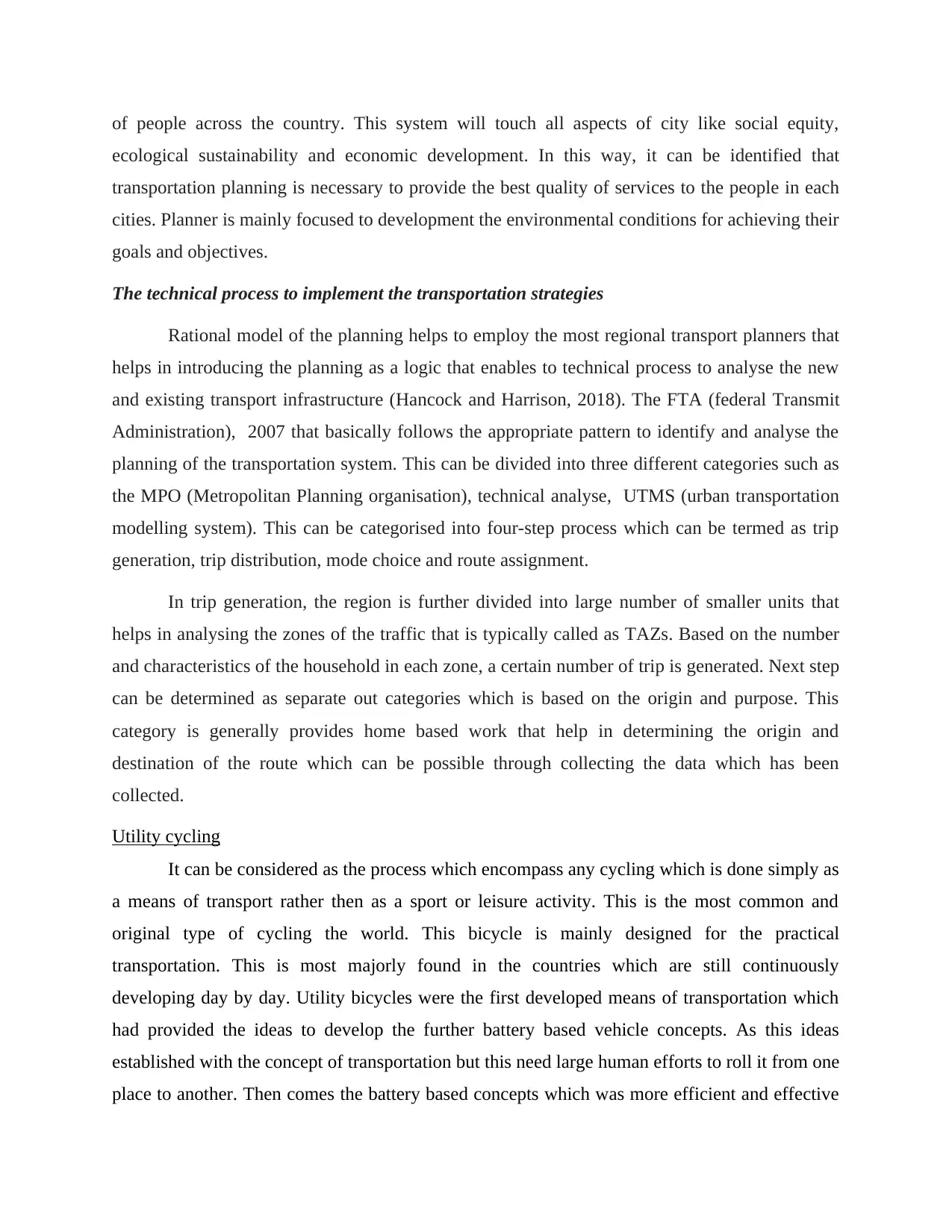
of people across the country. This system will touch all aspects of city like social equity,
ecological sustainability and economic development. In this way, it can be identified that
transportation planning is necessary to provide the best quality of services to the people in each
cities. Planner is mainly focused to development the environmental conditions for achieving their
goals and objectives.
The technical process to implement the transportation strategies
Rational model of the planning helps to employ the most regional transport planners that
helps in introducing the planning as a logic that enables to technical process to analyse the new
and existing transport infrastructure (Hancock and Harrison, 2018). The FTA (federal Transmit
Administration), 2007 that basically follows the appropriate pattern to identify and analyse the
planning of the transportation system. This can be divided into three different categories such as
the MPO (Metropolitan Planning organisation), technical analyse, UTMS (urban transportation
modelling system). This can be categorised into four-step process which can be termed as trip
generation, trip distribution, mode choice and route assignment.
In trip generation, the region is further divided into large number of smaller units that
helps in analysing the zones of the traffic that is typically called as TAZs. Based on the number
and characteristics of the household in each zone, a certain number of trip is generated. Next step
can be determined as separate out categories which is based on the origin and purpose. This
category is generally provides home based work that help in determining the origin and
destination of the route which can be possible through collecting the data which has been
collected.
Utility cycling
It can be considered as the process which encompass any cycling which is done simply as
a means of transport rather then as a sport or leisure activity. This is the most common and
original type of cycling the world. This bicycle is mainly designed for the practical
transportation. This is most majorly found in the countries which are still continuously
developing day by day. Utility bicycles were the first developed means of transportation which
had provided the ideas to develop the further battery based vehicle concepts. As this ideas
established with the concept of transportation but this need large human efforts to roll it from one
place to another. Then comes the battery based concepts which was more efficient and effective
ecological sustainability and economic development. In this way, it can be identified that
transportation planning is necessary to provide the best quality of services to the people in each
cities. Planner is mainly focused to development the environmental conditions for achieving their
goals and objectives.
The technical process to implement the transportation strategies
Rational model of the planning helps to employ the most regional transport planners that
helps in introducing the planning as a logic that enables to technical process to analyse the new
and existing transport infrastructure (Hancock and Harrison, 2018). The FTA (federal Transmit
Administration), 2007 that basically follows the appropriate pattern to identify and analyse the
planning of the transportation system. This can be divided into three different categories such as
the MPO (Metropolitan Planning organisation), technical analyse, UTMS (urban transportation
modelling system). This can be categorised into four-step process which can be termed as trip
generation, trip distribution, mode choice and route assignment.
In trip generation, the region is further divided into large number of smaller units that
helps in analysing the zones of the traffic that is typically called as TAZs. Based on the number
and characteristics of the household in each zone, a certain number of trip is generated. Next step
can be determined as separate out categories which is based on the origin and purpose. This
category is generally provides home based work that help in determining the origin and
destination of the route which can be possible through collecting the data which has been
collected.
Utility cycling
It can be considered as the process which encompass any cycling which is done simply as
a means of transport rather then as a sport or leisure activity. This is the most common and
original type of cycling the world. This bicycle is mainly designed for the practical
transportation. This is most majorly found in the countries which are still continuously
developing day by day. Utility bicycles were the first developed means of transportation which
had provided the ideas to develop the further battery based vehicle concepts. As this ideas
established with the concept of transportation but this need large human efforts to roll it from one
place to another. Then comes the battery based concepts which was more efficient and effective
⊘ This is a preview!⊘
Do you want full access?
Subscribe today to unlock all pages.

Trusted by 1+ million students worldwide
1 out of 21
Related Documents
Your All-in-One AI-Powered Toolkit for Academic Success.
+13062052269
info@desklib.com
Available 24*7 on WhatsApp / Email
![[object Object]](/_next/static/media/star-bottom.7253800d.svg)
Unlock your academic potential
Copyright © 2020–2025 A2Z Services. All Rights Reserved. Developed and managed by ZUCOL.





